Cotton is one of the most widely grown commercial crops in India, but cotton farming is not safe from pest and disease attacks. There are two types of pests that usually attack cotton: defoliators, which are leaf eaters, and sap-sucking pests. Leaf eaters are nowadays resisted by growing Bt cotton. But these sap-sucking pests, such as leaf hoppers, thrips, aphids, whiteflies, red and dusky cotton bugs, mirids and mealybugs, are still a headache for cotton farmers.
Therefore, it is important to identify these sap-sucking pests in cotton, understand what their damage looks like, and learn how to manage them.
Thrips in Cotton
Are you observing a rusty appearance in your field from a distance? Don’t think it is due to a nutrient deficiency, the real culprit might be thrips.
What are the Symptoms of Cotton Thrips?
The nymphal and adult stages of thrips mainly attack leaves and suck the sap from both the upper and lower surfaces. If you see slightly curled-up leaf margins and leaf blades with an uneven surface, you should look for thrips infestation symptoms.
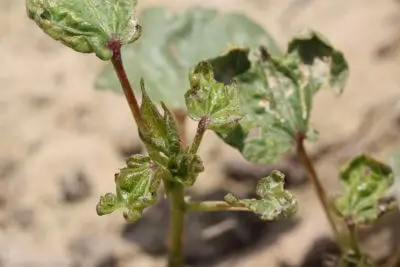
How Do You Identify Thrips?
If thrips attack cotton during the flowering stage, the flowers will wither. Thrips infestation in cotton is easy to identify by the lacerations under the leaf surface. You can also see silver or brown necrotic spots of 3-5 mm.

The eggs of thrips are kidney shades and are laid in slits of leaf tissues. Nymphs are pale yellow and are microscopic, adults appear to be small, slender and straw coloured with fringed wings.
Thrips attack should be monitored as it is the vector of yellow spot virus and spotted wilt virus.
How to Control Cotton Thrips?
- To keep cotton plants away from thrips, it’s better to plant them away from other host plants, such as onions, to prevent migration.
- Provide the proper amount of nitrogen, as excess nitrogen leads to succulent growth, which acts as shelter for thrips and increases the thrips population.
- Avoid late sowing, and ensure proper irrigation and adequate nutrients for the cotton plants.
- Plant french beans around the field as it acts as attractant crop to control thrips population.
- Before planting, treat the seeds with Beauveria bassiana at 10 g/kg of seeds.

- Place 6-8 yellow sticky traps to monitor the thrips incidence.
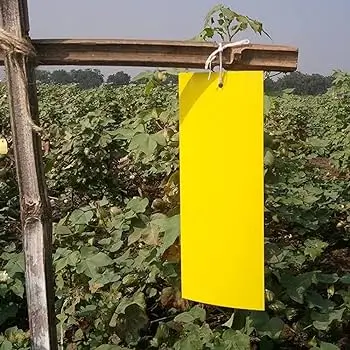
- Biopesticides such as neem oil should be sprayed at the rate of 1-2 ml per litre of water at the inter of 15 days is effective in keeping thrips away.
- Other biopesticides such as Beauveria bassiana and Verticillium lecanii can also be applied at the rate of 1-2 ml per litre of water.
What is the best chemical treatment for cotton thrips?
You can apply any one of these chemicals when pests reach the Economic Threshold Level (ETL) for thrips. This occurs when you observe more than 10 thrips per leaf or silvery patches on the underside of the leaves.
Pesticides containing Imidacloprid 17.8% SL (40 – 50 ml/acre) or Buprofezin 25%SC (400 ml/acre) or Diafenthiuron 50%WP (240 g/acre) or Thiacloprid 21.7%SC (40-50 ml/acre) or Flonicamid 50% WG (60 g/acre) or Thiamethoxam 25% WG (40 g/acre) or Fipronil5% SC (600-800 ml/acre) are some of the best pesticides for thrips control.
Aphids: Important Sucking Pests in Cotton
If you are seeing black sooty mould on the plants it is mostly likely to be caused by aphids.
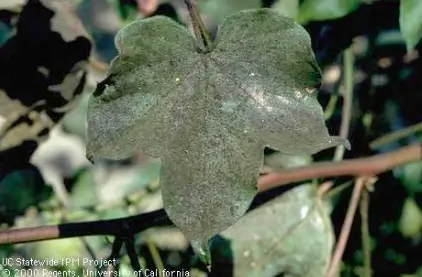
What are the Symptoms of Cotton Aphids?
The symptoms of aphids in cotton generally appear as curled leaves, and in later stages, the leaves dry up. You can observe honeydew secretion on the leaves, which later turns into sooty mould. Ants are often observed on the aphids, attacking cotton plants due to the honeydew secretion.
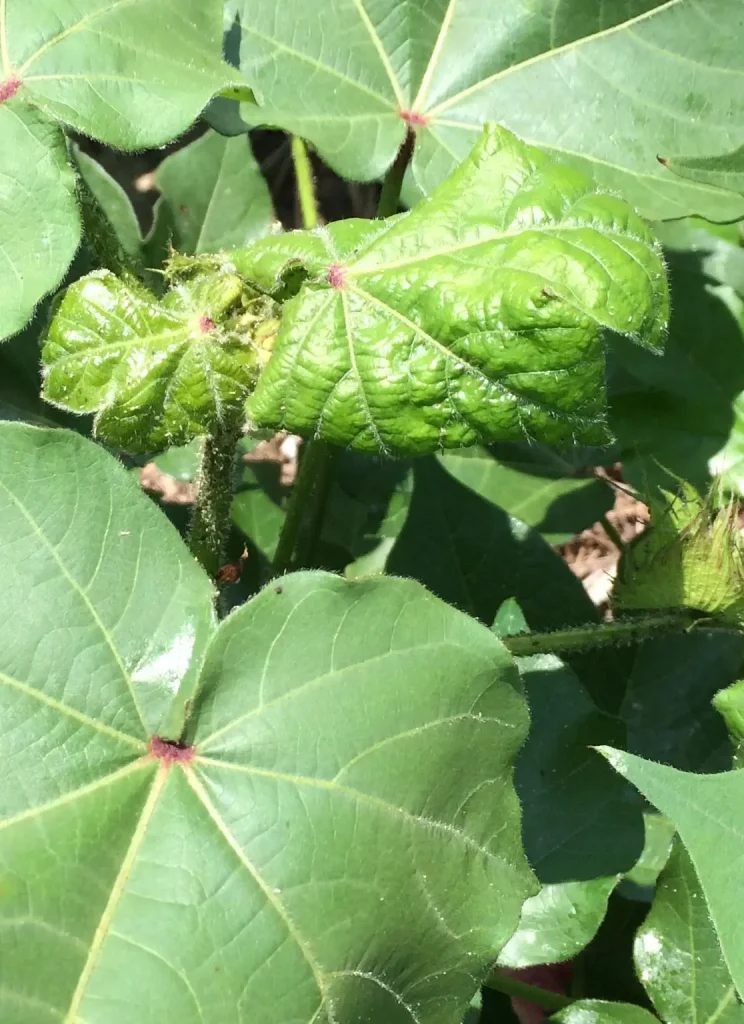
How Do You Identify Aphids?
The nymphal and adult stages of aphids are destructive. The nymphal stage appears as small, yellowish or brownish in colour, mostly wingless. Adults are yellowish-brown to black, with black cornicles and yellowish-green abdominal tips.
The control of aphids in cotton is crucial because the honeydew secretion contaminates the lint, which leads to poor quality cotton.
But what is the quick remedy for aphids? What is the chemical treatment for cotton aphids? How to control aphids in cotton?
Cotton Aphids Management
- Growing cowpea in the bunds helps increase natural enemy buildup, leading to aphids control.
- Avoid late sowing
- Give judicious amount of nitrogen to the plant
- Treat seeds with 10 grams of Beauveria bassiana per kilogram of seeds before planting
- Learn how to control different pests organically using Beauveria bassiana here
- You can also apply biopesticides such as neem oil as applied for thrips
- The ETL of aphids is indicated by cupping and curling of a few leaves on the upper portions of the plant. At this time, the best insecticides for aphid control are: Imidacloprid 17.8% SL (40–50 ml/acre), Azadirachtin 0.03% EC (1000 ml/acre), Buprofezin 25% SC (400 ml/acre), Diafenthiuron 50% WP (240 g/acre), Thiacloprid 21.7% SC (40–50 ml/acre), Flonicamid 50% WG (60 g/acre), or Thiamethoxam 25% WG (40 g/acre).
Learn how to control bollworms in cotton from here
Whiteflies in Cotton
Are you worried about the cotton leaf curl virus infecting your cotton plants? Then it is due to the presence of whiteflies in the field as they are the vectors for cotton leaf curl virus.
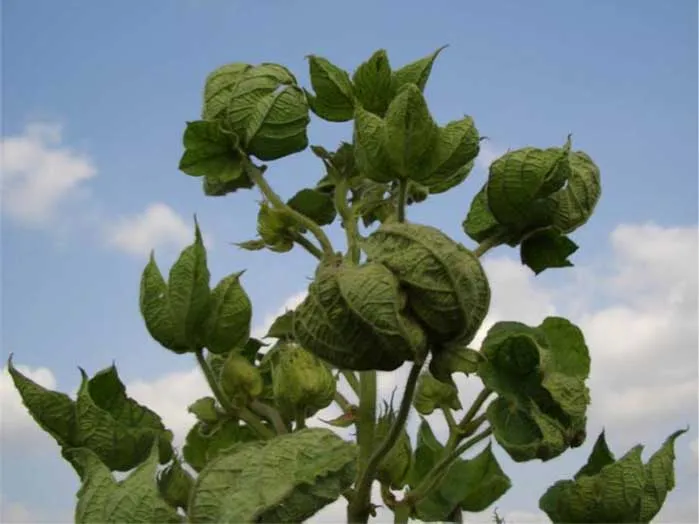
What are The Symptoms of Whiteflies in Cotton?
Both nymphal and adult stages of whiteflies cause damage to the cotton plant. The whiteflies’ symptoms appear as chlorotic spots on cotton leaves and you can also see upward curling of leaves. The whitefly attacked leaves become reddish and brittle. Keeping the eye on whitefly infestation is important as they can lead to premature boll shedding, boll bursting resulting in poor quality lint.
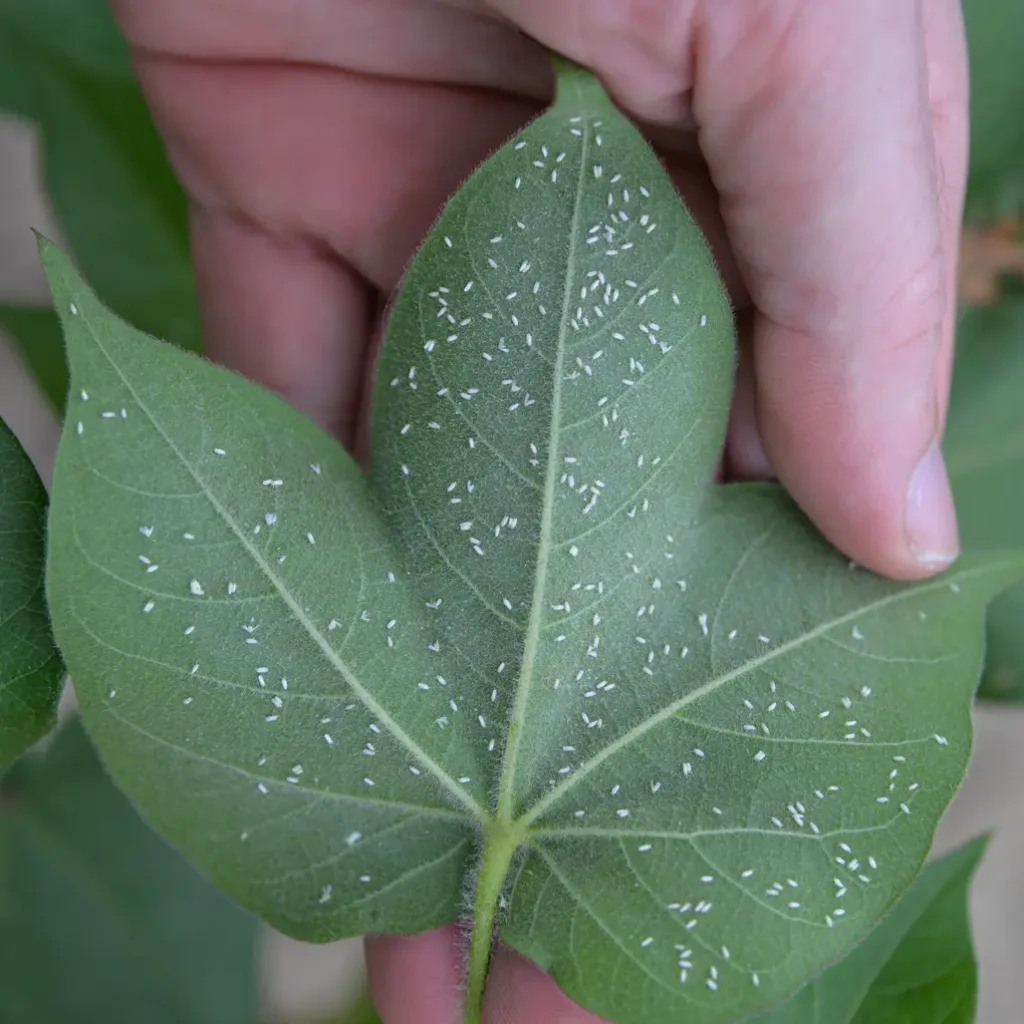
How Do You Identify Whiteflies?
If you see yellowish-white eggs on the underside of the leaves, then it is likely a whitefly. The nymphal stages appear greenish-yellow and are oval in shape. Pupae can also be found on the undersurface of the leaves and are oval. Adults are minute insects with yellow bodies covered in a white waxy bloom.
Management of Whiteflies in Cotton
- Avoid planting of cotton alternate to host plants such us brinjal, okra, tomato, tobacco and sunflower in the vicinity of cotton crop
- Keep the plot weed free and remove the weeds like Abutilon indicum and Solanum nigrum from the field if found as they act as the host for whiteflies
- Crop rotation is the key! Go for non host plants like sorghum, ragi or maize.
- Always be extra careful when it comes to sowing time. Avoid late sowing, and wide spacing is recommended.
- Use fertilisers judiciously, especially nitrogenous fertilisers, as they increase vegetative growth. Irrigation management is also important, as it helps to control pest buildup.
- Set yellow sticky traps to monitor whiteflies at 10 foot height above the plant canopy
- Spray any one of the following insecticides when the pest population reaches the Economic Threshold Level (ETL) (when the whitefly population exceeds 10 in the middle region of the plant in more than 50 percent of the total plants, or adults produce a smoky appearance when disturbed):
- Imidacloprid 17.8% SL 40 – 50 ml/acre or Buprofezin 25% SC 400 ml/acre or Diafenthiuron 50% WP 240 g/acre or Thiacloprid 21.7% SC 200 – 240ml/acre or Flonicamid 50% WG 60 g/acre or Thiamethoxam 25% WG 80 g/acre or Fipronil 5% SC 600-800 ml/acre.
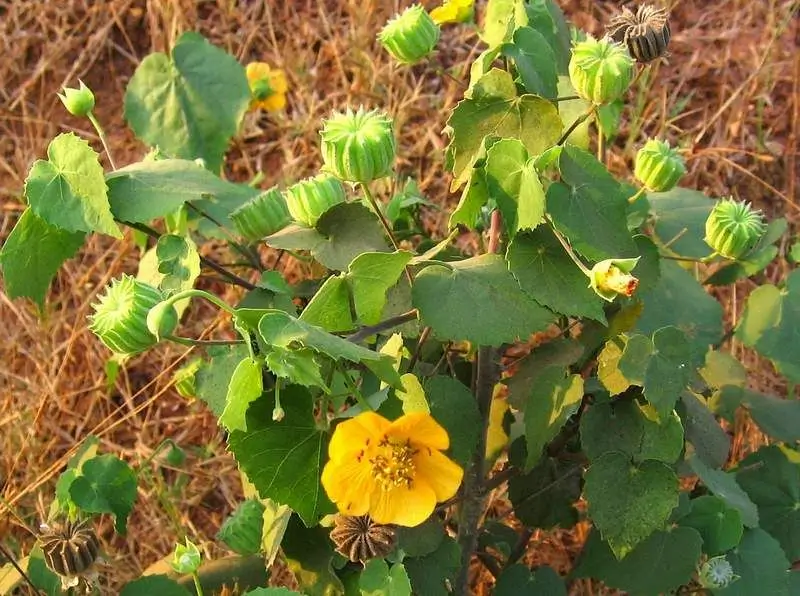

Leafhoppers: Major Sucking Pests in Cotton
Are you observing stunted cotton plants and experiencing reduced yields from your cotton cultivation? Keep an eye out for leafhopper attacks.
What are The Symptoms of Leafhopper Damage?
If your cotton leaves are showing downward curling, turning yellow, and in later stages turning red, leading to drying up and shedding, it is caused by leafhoppers. Hopper burn symptoms appear as plants turn a brick red colour. Leafhopper incidence in cotton can lead to the stunting of young cotton plants and a reduction in cotton yield.

How Do You Identify Leafhoppers?
Leafhoppers are minute pests with body colour red in winter and yellow colour in summer. Adult leafhopper is wedge shaped and it can be clearly identified as it moves diagonally when disturbed. You can observe black spots on each forewing and small black spots on the vertex.
How to Manage Leafhoppers in Cotton?
- It is the time to manage leafhoppers when you see 2 leafhoppers per leaf and when you are observing crinkling and curling of leaves in the lower portion of plants along with yellow margins.
- Treat seeds with Beauveria bassiana at the rate of 10 g per kg of cotton seeds
- Follow synchronised sowing and apply nitrogenous fertiliser judiciously
- Keep the plots weed free to grow hopper free cotton plants
- Chemical treatment becomes important when the pest population reaches ETL
- Chemicals such as Imidacloprid 17.8% SL 40 – 50 ml/acre or Azadirachtin 0.03%WSP or Buprofezin 25%SC 400 ml/acre or Diafenthiuron 50% WP 240 g/acre or Thiacloprid 21.7% SC 40-50 ml/acre or Flonicamid 50% WG 60 g/acre or Thiamethoxam 25% WG 40 g/acre acts as best pesticides to control leafhopper in cotton.
Hopefully, these practices will effectively address your pest issues. By understanding the damage caused by pests and following proper management practices, you can keep your plants healthy and boost your yield. However, always consult an expert before applying any chemicals.
Want to order these pesticides for your field? Looking for free crop advisory services? Download AgriApp today and improve your yield with better advice and products.
Don’t forget to apply our special coupon code RR150 for additional savings. Happy shopping!